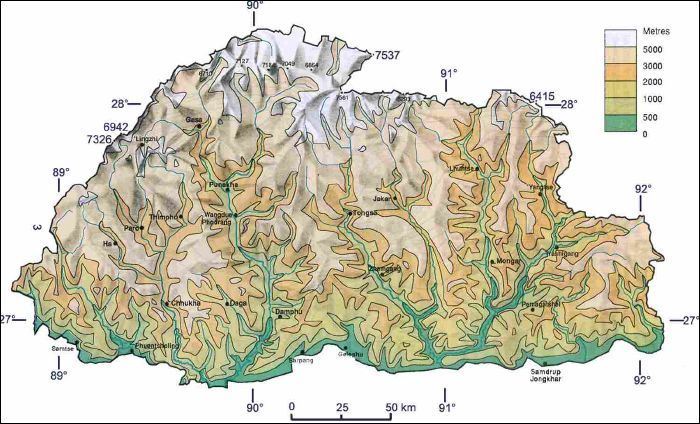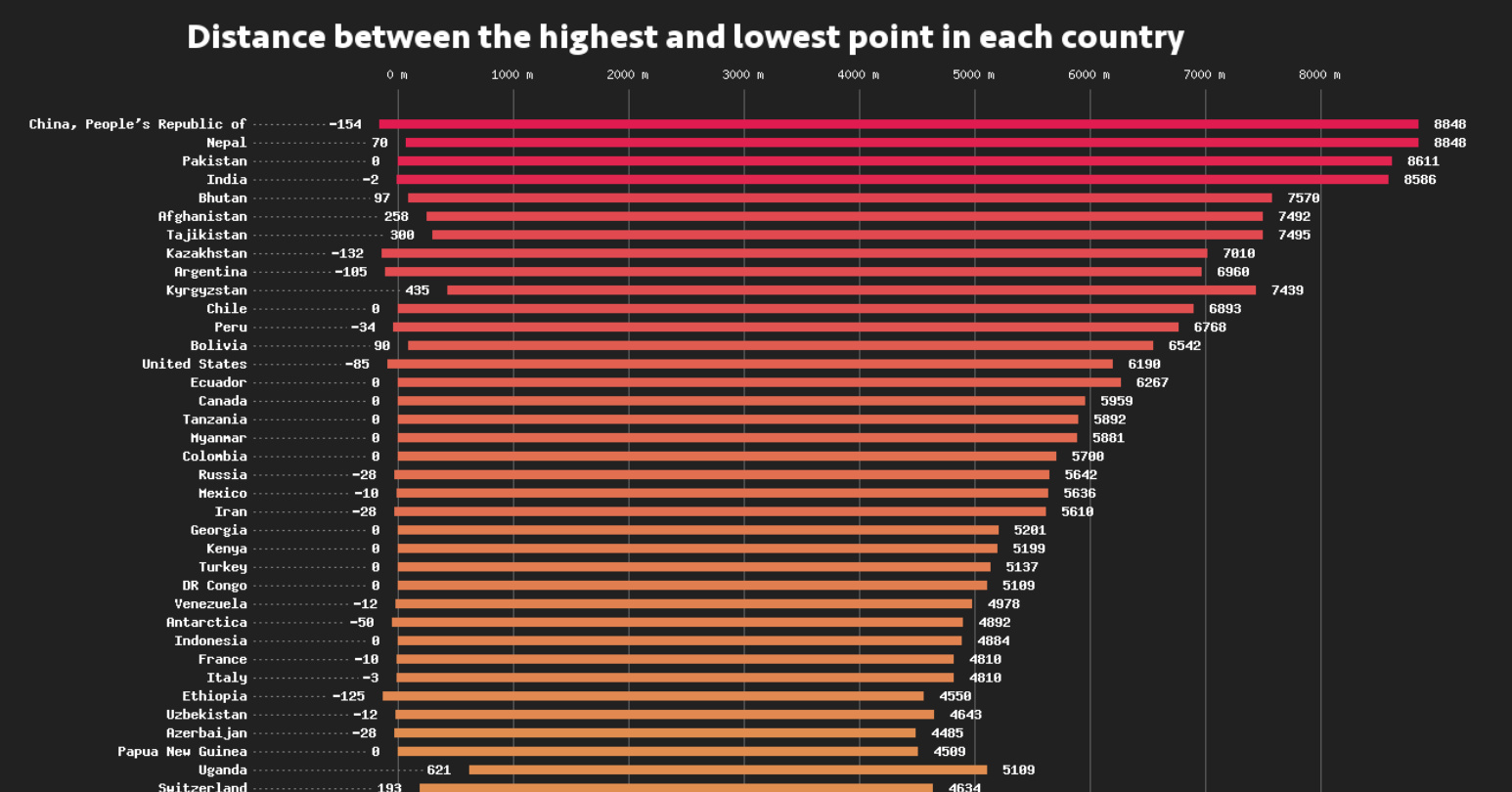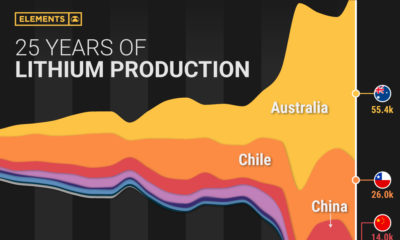Misc
The Elevation Span of Every Country in the World
View a high resolution version of this graphic.

The Elevation Span of Every Country in the World
View the high resolution version of today’s graphic by clicking here.
Giant countries like Canada or Russia can take their sprawling landmasses for granted, but for smaller oceanic nations, topography takes on greater importance.
In the Indian Ocean, ringed by protective barriers, lies the island city of Malé – the capital of the Maldives. Malé has a thriving tourism industry and is one of the most urbanized islands in the world, but it has one major problem: its elevation (or lack thereof).
Over 80% of the nation’s landmass is below 3.3 ft (1m), leaving it acutely vulnerable to the impacts of climate change. If sea levels continue to rise, the entire chain of islands, including the homes of half a million people, could be submerged in as soon as 30 years.
Breaking out the measuring stick
Today’s data visualization, via Fascinating Maps, is a global breakdown of every country’s elevation span, from the severe mountain peaks that dominate Bhutan’s landscape, to the sweltering Dead Sea depression that runs along the Israel–Jordan border.
By looking at the data, we see interesting patterns and unique situations emerge.
The Power of Zero: The median low-end land elevation of the world’s countries is zero. This is because shoreline typically makes up the lowest portion of a country’s terra firma. It’s easy to spot a landlocked country in the data set, as its lowest elevation is far more likely to be above sea level.
The Lowlands: In general, the smallest countries tend to have the smallest elevation spans, but some countries buck that trend. Denmark, which has a respectable 16,577 quare miles (42,933 sq. km) of land, has an elevation range of only 583 ft (178m). This means the highest point in the country is only 50m taller than its tallest building, Herlev Hospital, near Copenhagen.
The Highlands: Three countries – Nepal, Tajikistan, and Bhutan – have an average elevation that soars above 10,000 ft (3,050m). The latter country has the highest average elevation in the world.
Bhutan Elevation Map:

Supersized Elevation Span: China has the the largest elevation span of any country on Earth. The average elevation of the country skews high, thanks in part to the Tibetan Plateau. A number of the highest permanent settlements in the world exist in this region.
VC+
VC+: Get Our Key Takeaways From the IMF’s World Economic Outlook
A sneak preview of the exclusive VC+ Special Dispatch—your shortcut to understanding IMF’s World Economic Outlook report.

Have you read IMF’s latest World Economic Outlook yet? At a daunting 202 pages, we don’t blame you if it’s still on your to-do list.
But don’t worry, you don’t need to read the whole April release, because we’ve already done the hard work for you.
To save you time and effort, the Visual Capitalist team has compiled a visual analysis of everything you need to know from the report—and our VC+ Special Dispatch is available exclusively to VC+ members. All you need to do is log into the VC+ Archive.
If you’re not already subscribed to VC+, make sure you sign up now to access the full analysis of the IMF report, and more (we release similar deep dives every week).
For now, here’s what VC+ members get to see.
Your Shortcut to Understanding IMF’s World Economic Outlook
With long and short-term growth prospects declining for many countries around the world, this Special Dispatch offers a visual analysis of the key figures and takeaways from the IMF’s report including:
- The global decline in economic growth forecasts
- Real GDP growth and inflation forecasts for major nations in 2024
- When interest rate cuts will happen and interest rate forecasts
- How debt-to-GDP ratios have changed since 2000
- And much more!
Get the Full Breakdown in the Next VC+ Special Dispatch
VC+ members can access the full Special Dispatch by logging into the VC+ Archive, where you can also check out previous releases.
Make sure you join VC+ now to see exclusive charts and the full analysis of key takeaways from IMF’s World Economic Outlook.
Don’t miss out. Become a VC+ member today.
What You Get When You Become a VC+ Member
VC+ is Visual Capitalist’s premium subscription. As a member, you’ll get the following:
- Special Dispatches: Deep dive visual briefings on crucial reports and global trends
- Markets This Month: A snappy summary of the state of the markets and what to look out for
- The Trendline: Weekly curation of the best visualizations from across the globe
- Global Forecast Series: Our flagship annual report that covers everything you need to know related to the economy, markets, geopolitics, and the latest tech trends
- VC+ Archive: Hundreds of previously released VC+ briefings and reports that you’ve been missing out on, all in one dedicated hub
You can get all of the above, and more, by joining VC+ today.
-

 Mining1 week ago
Mining1 week agoGold vs. S&P 500: Which Has Grown More Over Five Years?
-

 Markets2 weeks ago
Markets2 weeks agoRanked: The Most Valuable Housing Markets in America
-

 Money2 weeks ago
Money2 weeks agoWhich States Have the Highest Minimum Wage in America?
-

 AI2 weeks ago
AI2 weeks agoRanked: Semiconductor Companies by Industry Revenue Share
-

 Markets2 weeks ago
Markets2 weeks agoRanked: The World’s Top Flight Routes, by Revenue
-

 Countries2 weeks ago
Countries2 weeks agoPopulation Projections: The World’s 6 Largest Countries in 2075
-

 Markets2 weeks ago
Markets2 weeks agoThe Top 10 States by Real GDP Growth in 2023
-

 Demographics2 weeks ago
Demographics2 weeks agoThe Smallest Gender Wage Gaps in OECD Countries















